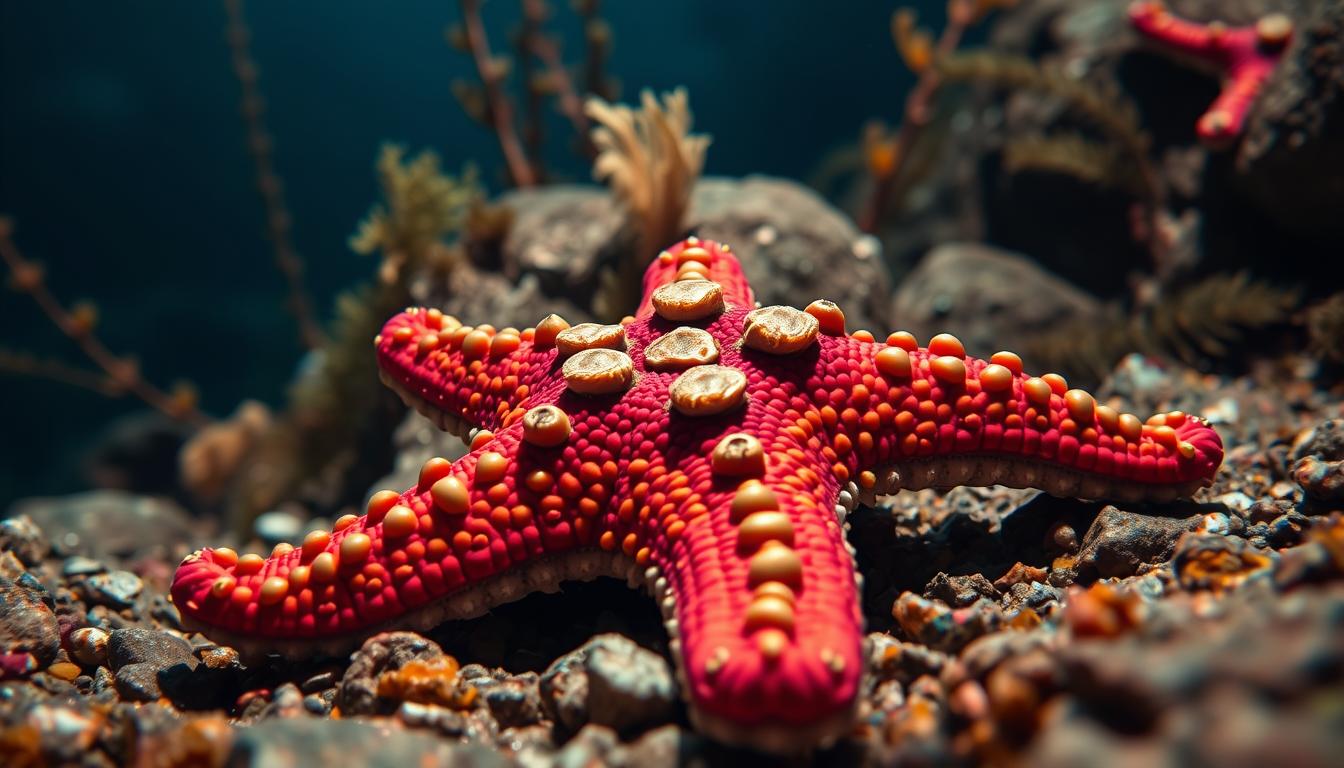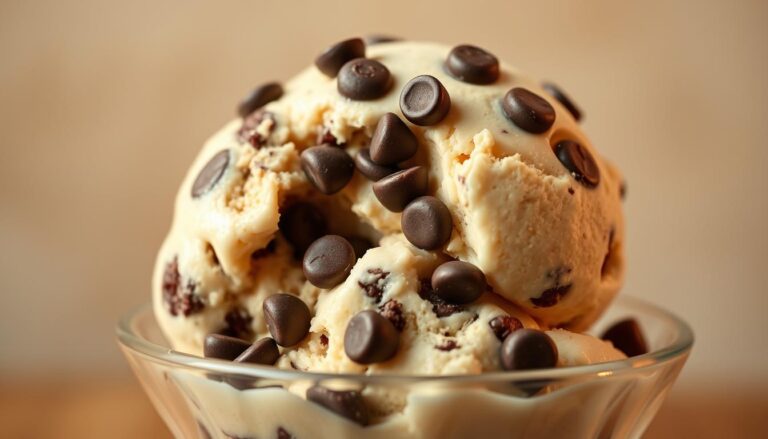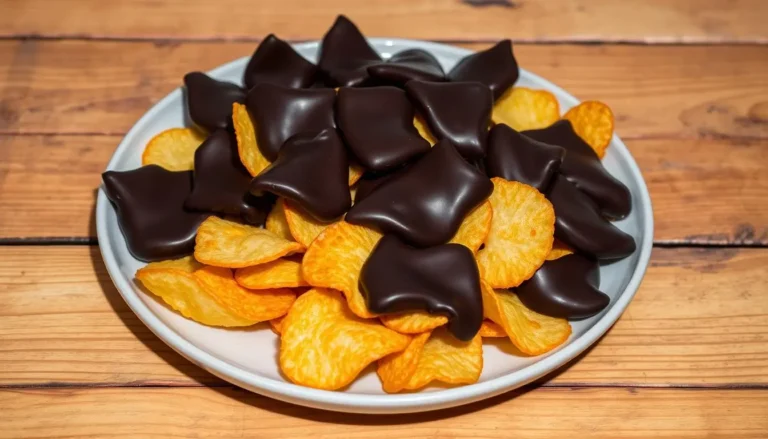Chocolate Chip Starfish: A Unique Treat for Seafood Lovers
Imagine diving into the crystal-clear waters of the Indo-Pacific. There, you might see a marine creature that looks like it’s been sprinkled with chocolate chips. The Chocolate Chip Starfish (Protoreaster nodosus) is nature’s delightful surprise, reminding us of those tempting chocolate covered potato chips we can’t resist.
These sea dwellers capture our imagination with their unique appearance and fascinating characteristics. Unlike typical snack foods, these starfish are living, breathing marine marvels. They inhabit the warm, shallow waters of tropical regions.
Their distinctive bumpy texture and rich coloration make them stand out in the underwater landscape. This creates a visual feast that rivals any gourmet treat. As you explore the world of these incredible marine creatures, you’ll discover a species that’s both scientifically fascinating and visually stunning.
From their intricate biology to their remarkable survival strategies, the Chocolate Chip Starfish represents an extraordinary example of marine life’s creativity and complexity.
Table of Contents
Introduction to the Fascinating World of Chocolate Chip Starfish
Marine lovers and aquarium fans are drawn to the chocolate chip starfish. It brings the ocean’s wonders to life. These creatures show us the beauty of underwater worlds with their unique looks and interesting traits.
The chocolate chip starfish gets its name from its chocolate spots. These spots remind us of tasty treats in gourmet food. It’s a natural wonder that fascinates both marine biologists and underwater fans.
Scientific Classification
This starfish is known as Protoreaster nodosus. It’s part of a group of marine animals that are quite interesting. Here’s where it fits in the marine world:
- Kingdom: Animalia
- Phylum: Echinodermata
- Class: Asteroidea
- Family: Oreasteridae
Natural Habitat and Distribution
The chocolate chip starfish lives in the warm waters of the Indo-Pacific. It can be found in many marine places, like coral reefs and seagrass beds.
| Geographic Range | Specific Locations |
|---|---|
| Indonesia | Coral reef systems |
| Solomon Islands | Shallow marine ecosystems |
| Southern Japan | Coastal marine environments |
| Seychelles | Tropical marine habitats |
Historical Discovery
Marine scientists first found these creatures in the late 1800s. Their unique look caught the eye of scientists, just like how tasty treats excite food lovers. The chocolate chip starfish shows nature’s creativity in the sea.
Physical Characteristics and Appearance
The chocolate chip starfish is a unique sea creature. It looks like a snack with its special look. The small, dark brown bumps on its body remind us of chocolate chips on potato chips.
These sea animals have amazing features that make them easy to spot underwater. The bumps, or tubercles, are not just for looks. They help protect the starfish from predators.
- Color Range: Typically beige to light brown with dark brown tubercles
- Average Size: 4-6 inches in diameter
- Distinctive Markings: Raised brown bumps across entire body surface
The starfish’s appearance is key to its survival. The bumps act as a shield, keeping predators away. Unlike potato chip confections that tempt taste buds, these bumps are purely functional in the marine ecosystem.
| Physical Characteristic | Description |
|---|---|
| Body Shape | Five-pointed star with rounded arms |
| Skin Texture | Rough with prominent chocolate chip-like tubercles |
| Primary Color | Light beige with dark brown raised bumps |
Marine lovers are amazed by these starfish. They look like an underwater treat. Their unique look shows nature’s creativity in the sea.
Understanding the Chocolate Chip Starfish’s Natural Habitat
Dive into the fascinating world of the chocolate chip starfish. This marine creature is as unique as gourmet chip flavors. They have specific environmental preferences that make their habitat special.
The chocolate chip starfish thrives in marine environments that are just right for them. Their habitat choices are as precise as picking the perfect chocolate-dipped chips for a gourmet treat.
Preferred Water Conditions
These starfish demand specific water parameters to flourish. They prefer:
- Tropical marine environments
- Clear, well-circulated waters
- Stable salinity levels
- Moderate water movement
Substrate Requirements
The ocean floor is crucial for their survival. Chocolate chip starfish like:
- Soft, sandy bottoms
- Muddy seafloor areas
- Regions with seagrass coverage
- Shallow lagoon environments
Depth and Temperature Preferences
Understanding their ideal living conditions is key. They typically inhabit:
- Depths between 3-30 meters
- Water temperatures of 72-82°F
- Tropical and subtropical reef systems
“The chocolate chip starfish’s habitat is a delicate ecosystem as intricate as the most refined gourmet chip flavors.” – Marine Biology Research Institute
Each aspect of their environment contributes to their survival. This makes them a testament to nature’s remarkable design.
Size and Growth Patterns
Knowing about the size and growth of chocolate chip starfish is key for aquarium fans. These marine wonders grow like specialty potato chips with fancy toppings – each one unique and special.
Chocolate chip starfish grow in a way that’s different from other sea creatures. They can get up to 16 inches wide, with most being 8-10 inches. Their main body, the central disk, can grow up to 5 inches.
- Maximum overall diameter: 16 inches
- Average size range: 8-10 inches
- Central disk size: Up to 5 inches
- Individual arm length: Up to 5.5 inches
Several things affect how big your chocolate chip starfish will get. Just like how toppings make potato chips better, good food is key. The right tank, water, and diet help them grow well.
Young starfish grow fast, but slow down as they get older. Watching their size helps you see if they’re healthy and need any changes in care.
Proper nutrition and care are essential for supporting the unique growth patterns of these marine marvels.
Lifespan and Development Stages
Marine fans and aquarium lovers need to know about chocolate chip starfish life cycles. These creatures go through stages as complex as making chocolate covered potato chips.
The life span of chocolate chip starfish changes a lot between wild and home environments. Scientists have found interesting growth patterns. These patterns show how these creatures survive.
Growth Milestones
Chocolate chip starfish have key developmental stages:
- Larval Stage: Initial microscopic phase lasting several weeks
- Juvenile Stage: Rapid growth and initial coloration development
- Mature Adult Stage: Full size and reproductive capabilities
Age-Related Changes
As these marine creatures age, they change a lot. It’s like how snack foods change during making. Their looks and behaviors change over time.
| Life Stage | Typical Duration | Key Characteristics |
|---|---|---|
| Larval Phase | 2-4 weeks | Microscopic, planktonic movement |
| Juvenile Phase | 6-12 months | Rapid growth, developing color patterns |
| Adult Phase | 10-17 years | Full size, reproductive maturity |
Wild chocolate chip starfish can live up to 17 years. Home ones live about seven to ten years with good care. Their long life depends on water quality, food, and their environment.
Essential Tank Requirements
Setting up a home for your chocolate chip starfish is like mixing the perfect sweet and salty treats. The right tank environment is key for these marine creatures to do well in captivity.
Choosing the right tank size is important. A 20-gallon tank is the minimum needed for your starfish to be happy. Bigger tanks have many benefits:
- Less stress for the starfish
- Stable water conditions
- More room to move
- Healthier marine life
To create a great home for your starfish, focus on their natural habitat. Here are key elements to include:
- Substrate Selection: Fine sand or crushed coral to mimic the ocean floor
- Rock Formations: Provide hiding spots and places to climb
- Water Flow: Use moderate current generators for ocean-like conditions
Invest in special equipment for the best care. Good filtration, protein skimmers, and temperature control are essential. They help keep your tank healthy and stable.
Water Parameters and Quality Management
Managing water for chocolate chip starfish is as precise as making potato chip confections. These marine creatures need exact environmental conditions to thrive.
Creating the perfect aquatic environment is key for your starfish’s health. It’s like preparing gourmet potato chip confections – every detail counts.
Temperature Control Essentials
Keeping water temperature consistent is vital for your starfish. The best temperature range is:
- Minimum temperature: 72°F
- Maximum temperature: 81°F
- Ideal stable range: 76-78°F
pH and Salinity Levels
Your starfish needs specific water chemistry to thrive. Important parameters include:
| Parameter | Recommended Range |
|---|---|
| pH Levels | 8.1 – 8.4 |
| Specific Gravity | 1.021 – 1.025 |
| Water Hardness | 8 – 12 dKH |
Maintenance Schedule
Regular checks prevent health problems. Your routine should include:
- Weekly water parameter testing
- Bi-weekly partial water changes
- Monthly comprehensive water quality assessment
Pro tip: Treat your starfish’s water environment like an artisan preparing indulgent snacks – with meticulous attention to detail and consistent care.
Dietary Needs and Feeding Habits
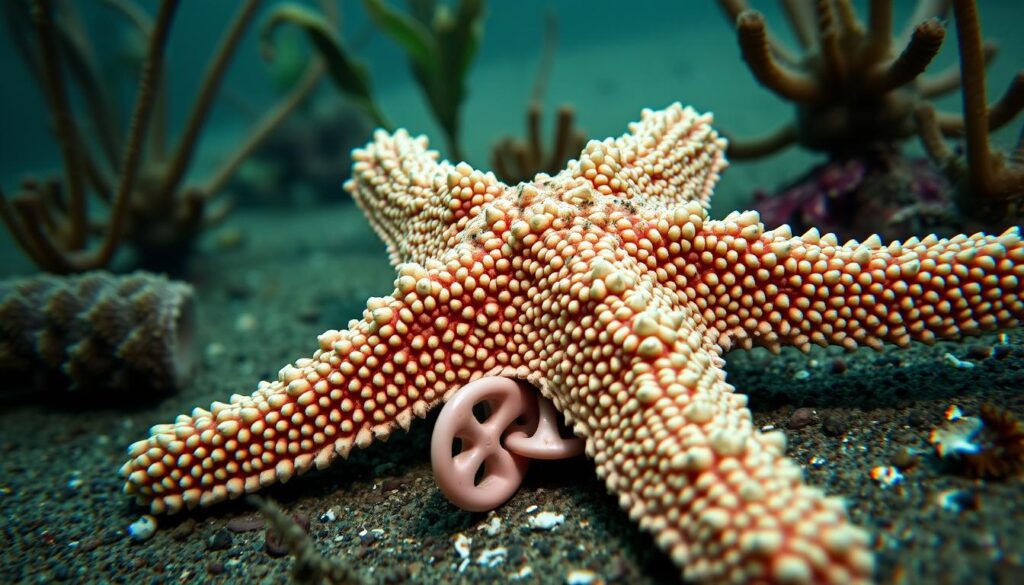
Chocolate chip starfish have special dietary needs that make them interesting marine scavengers. They are like the excitement that chocolate-dipped chips bring to food. Their eating habits are complex and fascinating.
In their natural home, these starfish show amazing eating patterns. They mainly eat:
- Dead marine organisms
- Small invertebrates
- Decaying marine matter
- Algae and microorganisms
For your chocolate chip starfish to do well, you need to plan their diet carefully. Think of their food like choosing gourmet chip flavors – variety is important. They need regular meals and specific foods.
| Feeding Frequency | Recommended Food Types | Quantity |
|---|---|---|
| Every 1-2 weeks | Shrimp pieces | Small portions |
| Supplemental feeding | Frozen marine proteins | Minimal amounts |
| Opportunistic feeding | Detritus and tank waste | Continuous |
When you feed your starfish, remember to be moderate. Too much food can harm their digestive system and the tank’s balance. Watch how they react and adjust their meals, just like a chef does with flavors.
Chocolate Chip Starfish Behavior Patterns
Exploring the world of chocolate chip starfish shows us complex behaviors. These marine creatures move and interact with each other in fascinating ways. It’s like watching how different toppings are layered on specialty potato chips.
Their movement is truly amazing. It’s like they have a built-in hydraulic system. This lets them glide across the ocean floor with grace.
Unique Movement Techniques
- Water vascular system powers tube feet
- Precise directional control through fluid dynamics
- Ability to move across various marine substrates
Chocolate chip starfish are very adaptable in how they move. Their tube feet act like tiny pumps. This helps them move smoothly over reefs, much like how you need to place specialty potato chips carefully.
Social Interaction Patterns
These starfish have complex social behaviors. They talk to each other through chemical signals and body language. Their interactions are like a dance, balancing their own needs with the group’s well-being.
- Communicate through chemical signals
- Maintain careful spatial relationships
- Respond to environmental stimuli collectively
Learning about their behavior helps us understand the ocean better. It shows how these creatures navigate their world with the same skill as a chef making delicious chip toppings.
Health and Disease Prevention
Keeping your chocolate chip starfish healthy is like taking care of snack foods. These sea creatures face many health issues that can harm them quickly.
Marine bacterial infections are a big threat to chocolate chip starfish. You should watch out for:
- Marine Ich: White spots on their bodies
- Velvet disease: Soft, powdery spots
- Bacterial infections: Can damage their tissues
To prevent disease, create a great marine environment. Just like with snack foods, paying attention to details is key. Check the water often, keep the right temperature, and keep the substrate clean.
Here are some prevention tips:
- Quarantine new sea creatures before adding them to your tank
- Keep the water quality consistent
- Feed them well
- Watch for stress signs
Spotting problems early is your best defense. Look for changes in how they act, eat, or look. Just as you handle chocolate covered potato chips with care, your starfish needs attention to do well in its home.
Proactive care is always better than reactive treatment in marine ecosystems.
Compatible Tank Mates and Community Setup
Setting up a tank for your chocolate chip starfish is like mixing sweet and salty treats. The right tank mates can make your aquarium a lively underwater world.
Your chocolate chip starfish needs a special home. Choose peaceful friends that won’t disturb them.
Recommended Fish Species
Here are some good tank mates:
- Clownfish
- Gobies
- Blennies
- Tangs
- Angelfish
- Butterflyfish
Species to Avoid
Some fish and invertebrates can harm your starfish. Stay away from aggressive ones to keep the tank calm.
Stay clear of these aggressive species:
- Triggerfish
- Large wrasses
- Predatory crabs
- Aggressive eels
Setting up your tank is like making the perfect mix of sweet and salty. Each fish adds to the harmony of your underwater world.
Breeding and Reproduction
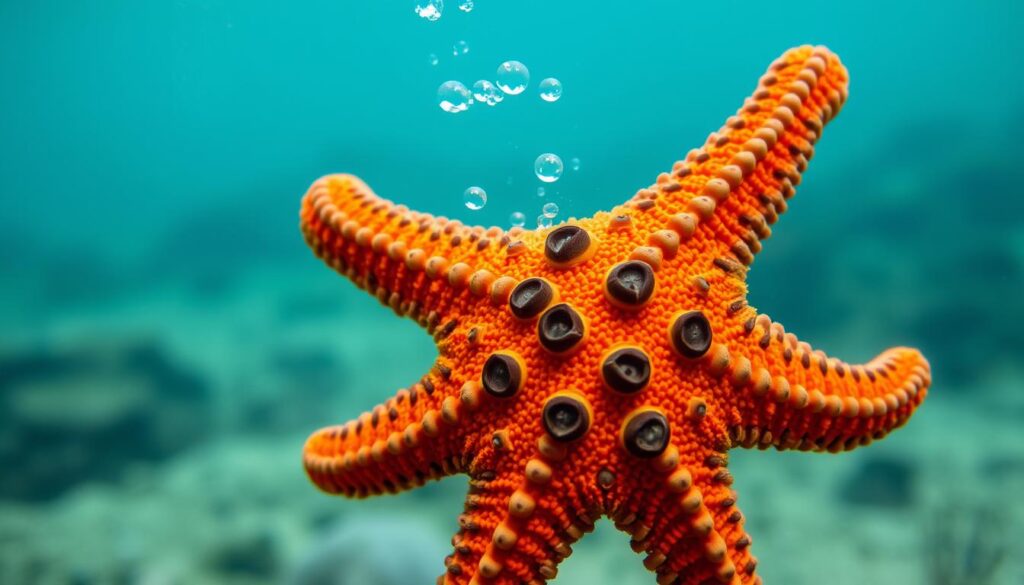
Learning about chocolate chip starfish reproduction is like making the finest potato chip treats. These sea creatures start their reproductive journey when they are about 2 to 3 years old.
Starfish reproduction is a complex dance of marine biology. Unlike making tasty snacks, their mating process has unique traits:
- Sexual reproduction occurs through external fertilization
- Males and females are visually identical
- Precise identification requires microscopic examination
The reproductive cycle of these marine creatures involves several critical stages:
- Maturation: Reaching approximately 3 inches in diameter
- Spawning: Release of reproductive cells into water
- Fertilization: External combination of eggs and sperm
| Reproduction Stage | Key Characteristics | Duration |
|---|---|---|
| Sexual Maturity | 2-3 years old | Continuous |
| Spawning Period | External cell release | Seasonal |
| Larval Development | Microscopic planktonic stage | Several weeks |
Breeding chocolate chip starfish in captivity is as challenging as making perfect potato chip treats. Aquarists must create precise environmental conditions for successful reproduction.
Setting Up the Perfect Habitat
Creating the perfect home for your chocolate chip starfish is like making gourmet chip flavors. It needs precision and detail. These marine creatures need a habitat that looks like their natural home.
Start by picking the right substrate. It’s key for their comfort and survival. Think of it as the base of a chocolate-dipped chip.
- Choose a sandy bottom with 4-5 inches of depth
- Add live rock for exploration and hiding spaces
- Ensure adequate tank space for movement
- Maintain clean, stable water conditions
Setting up your aquarium is like making a gourmet chip flavor. Each part adds to the whole experience. Place live rocks to make interesting terrain without crowding.
Lighting and filtration are crucial. Use moderate lighting that doesn’t stress them. Choose a filtration system that keeps water quality good without strong currents.
The perfect habitat is a delicate balance of environment, care, and understanding.
Remember, your chocolate chip starfish needs a stable, well-kept ecosystem to do well. Treat their habitat with the same care as making exquisite chocolate-dipped chips.
Common Challenges in Starfish Care
Caring for chocolate chip starfish is like making specialty potato chips. It needs precision and detail. These marine creatures come with their own set of challenges, even for seasoned aquarium fans.
To keep your chocolate chip starfish healthy, you must know and tackle potential issues early. The biggest hurdles are their environmental sensitivity and the need for precise care.
Critical Troubleshooting Issues
- Air Exposure Risks: Moving starfish can be risky because of air bubble dangers
- Water quality changes can upset their delicate marine homes
- Feeding them can be tricky, and they need the right food
- They can get stressed if their tank isn’t right
Prevention Strategies for Optimal Care
- Handle them less and avoid air bubbles during moves
- Keep the water quality steady
- Make sure their environment is calm and safe
- Watch their diet and eating habits closely
“Caring for starfish is an art form that requires patience, precision, and understanding of their unique marine ecosystem.”
Just as making specialty potato chips needs careful ingredient choice and prep, starfish care demands attention to detail. Your dedication to learning about these challenges will help your marine friend thrive.
Tips for Successful Acclimation
Introducing a chocolate chip starfish to a new aquarium is like preparing snack foods. It needs careful attention for the starfish’s survival and health.
Acclimation should be done with precision and patience. It’s like making chocolate covered potato chips. The drip method is the best way to introduce your starfish to its new home.
- Start by floating the transport container in your aquarium for 15-20 minutes
- Use a clean airline tube to create a slow drip rate
- Aim for 2-4 drips per second into the container
- Continue until the water volume has doubled
Experts say this slow method helps avoid stress. Sudden changes can be deadly for marine creatures like the chocolate chip starfish.
“Patience during acclimation is the key to a healthy, thriving starfish.” – Marine Biology Research Institute
Look for signs of distress during acclimation. A healthy starfish will stay calm. If it acts strangely, stop and check your method.
Every starfish is different, like various snack foods need different prep. Your careful steps during this time will help your starfish adapt well to its new home.
Conservation Status and Environmental Impact
Chocolate chip starfish are vital in marine ecosystems, much like unique flavors add depth to food. They are found in Indo-Pacific waters and their numbers are stable.
These creatures are important for more than just being in the sea. Marine biologists say they play a big role in keeping reefs healthy. They also help clean the sea floor and are food for some sea animals.
While we enjoy sweet and salty treats, these starfish fascinate scientists with their role in the sea. Their numbers are strong, which means we don’t need to worry about them right now.
But, there are things that could affect them:
- Changes in the sea due to climate change
- Being taken from the wild for aquariums
- Damage to coral reefs
Knowing about their conservation status helps protect these amazing sea creatures. It’s important to have good aquarium practices and keep studying them. This helps keep their delicate balance in the sea.
Protecting marine biodiversity requires collective awareness and action.
Conclusion
Diving into the world of chocolate chip starfish is like exploring an underwater landscape of indulgent snacks. These unique marine creatures bring a touch of culinary-inspired wonder to your saltwater aquarium. While they may not be reef safe, their distinctive appearance and intriguing behavior make them a captivating addition for marine enthusiasts willing to invest time and care.
Caring for chocolate chip starfish requires dedication similar to crafting perfect potato chip confections. You’ll need to create a precise environment that supports their health and longevity. A spacious tank, carefully managed water parameters, and strategic placement can help these fascinating sea stars thrive for up to two decades. Remember that their success depends on your commitment to understanding their specific needs.
Your journey with chocolate chip starfish will be a rewarding experience that goes beyond typical marine keeping. These creatures demand respect, careful observation, and a deep appreciation for marine ecosystems. By providing the right conditions and avoiding potential predators, you’ll create a vibrant underwater world that showcases the beauty and complexity of these remarkable marine invertebrates.
Whether you’re a seasoned aquarium enthusiast or a curious newcomer, chocolate chip starfish offer a unique opportunity to connect with marine life. Approach their care with patience, research, and a genuine passion for underwater exploration.

